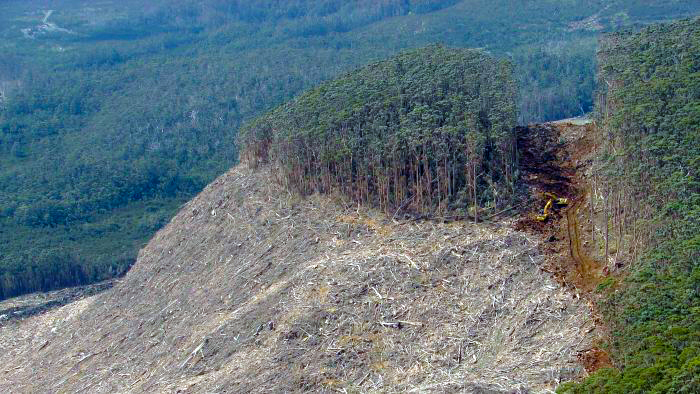The arrival of a comprehensive assessment of Tasmania’s forest carbon is a victory for commonsense over ideology.

WORTH MORE STANDING? The CO2 Australia report has put carbon storage firmly on the agenda in the debate over the future of our forests. PHOTO ABC NEWS
Ideology is the curse of modern humanity. That’s the message from wars and social strife in our time.
We couldn’t have built democratic societies without our ideologies. But just as they made us what we are, so they’re unmaking us, hindering sensible citizenship and government and threatening to unravel the fabric of communities we struggled so hard to build.
The public debate raging around Tasmanian forestry has been fuelled and sustained not by economic or practical needs, and certainly not science, but by ideology.
Tasmania’s big trees bring many benefits. They support diverse ecosystems and help stabilise our climate by converting carbon dioxide into solid carbon, with life-sustaining oxygen as a by-product. Cut down, their wood can be used to make houses, furniture, boats and paper.
We want our forests to last indefinitely, so we need to work out how much of our forest resource is available for wood and how much should be left to sustain those other benefits. We might disagree on how much we can afford to cut down, but even so this should be an ideology-free zone.
Not a bit of it. In the first place, many conservationists have supported their case with age-old notions about forests as holy places and harvesting as sacrilege. It’s an attractive position for many people, but it does nothing for rational argument.
If such irrationality were confined to conservationists it might be possible to work around it, but that’s not so. Advocates for timber harvesting have been just as unreasonable, claiming exclusive rights and ownership of all necessary knowledge, and treating opponents as ignorant intruders.
Take the weighty matter of forest carbon. Tasmanian forests could be a money-spinner as a carbon bank, but first we need to know how much is in the account. If ever an agency was tailor-made for such an assessment, this was surely Forestry Tasmania with its professional workforce.
As long ago as 2000 a project funded by the company assessed carbon loss from regeneration burning. In 2009 Forestry Tasmania executives told me that its professional foresters were equipped to assess forest carbon stocks and flows, in live vegetation, debris and soil. I’m sure they were right.
So Forestry Tasmania could have done this. To win public acceptance it could have made it an open, public process, inviting its “enemies” to be involved. It could have declared the resulting data to be common property, available to help inform government decisions on harvesting limits.
This didn’t happen. First, the agency claimed its forest carbon data was unavailable for the public to see because it had commercial value. Then it set up its own carbon study, limited to live biomass in standing trees in state forest and excluding forest debris – dead stems and branches, leaves and bark – which makes up about 40 per cent of the total amount of above-ground carbon in a forest.
All the while it maintained a high level of antagonism towards its equally intransigent opponents. Its partisanship put it out of contention to be a prime mover in the assessment of Tasmania’s forest carbon resource. Another win for ideology.
But it’s never too late to fix things. Last December the government contracted a Melbourne company, CO2 Australia, to assess carbon stocks and flows in forests and plantations on public and private land in Tasmania. The company handed its report to the Minister for Climate Change, Cassy O’Connor, early this month.
CO2 Australia’s study drew on data from the Wilderness Society, the University of Tasmania and other research institutions, and several government agencies. Notably, its sources included “a very significant set of data and information provided by Forestry Tasmania”.
The study concluded that carbon currently held in Tasmanian forests and plantations, expressed as the amount of greenhouse gas withheld from the atmosphere, is between 3 and 4.4 billion tonnes. Ninety-seven per cent of this is held in living plant tissue, debris and soil in native forest, as against just three per cent in plantations.
The assessment may be conservative — it assumes that older forests stop sequestering carbon and that eventually wet eucalypt forest always reverts to rainforest — but it’s light years ahead of where we were, and a sound basis for planning how we turn forest carbon storage into real money.
Realising forest carbon assets means trading carbon credits in a marketplace. Trading on the international voluntary market is an option that some forest owners are already exploiting, but far bigger returns would be available if forest carbon were to be included in Australia’s pricing scheme.
O’Connor sent a copy of the report to her federal counterpart, Greg Combet, as soon as it was released, with the view to discussing with him as soon as possible ways to make forest carbon tradeable under the mandatory Australian scheme.
Premier Lara Giddings said that this could happen “with a stroke of the pen”, creating a new kind of value in our trees. This is too pat. The Gillard government still has a fair bit of work ahead to figure out how its scheme can accommodate forest carbon.
The still-fiery debate about how many hectares of forest we should set aside in reserves has barely touched on carbon trading, because to do so requires seeing a value in trees left standing, a 180-degree shift from the traditional view of a tree’s economic worth
Forest carbon trading won’t in itself make a smidgin of difference to our carbon footprint — that requires physical changes to the way we do things including how we manage our trees. But at least it would be reward for having kept more of our forest than any other Australian state.
